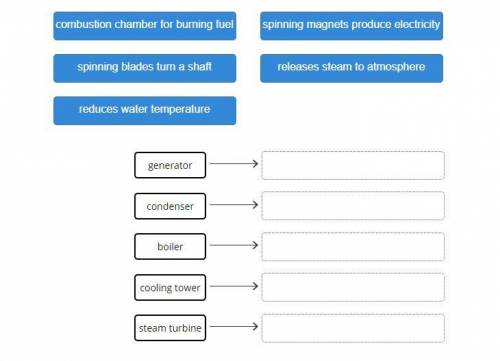
Engineering, 13.08.2021 19:10 shakira11harvey6
Drag each tile to the correct box.
Match each thermal energy system component to its role in power generation.
combustion chamber for burning fuel
spinning magnets produce electricity
spinning blades turn a shaft
releases steam to atmosphere
reduces water temperature


Answers: 1


Other questions on the subject: Engineering

Engineering, 04.07.2019 18:10, agpraga23ovv65c
Carbon dioxide gas expands isotherm a turbine from 1 mpa, 500 k at 200 kpa. assuming the ideal gas model and neglecting the kinetic and potential energies, determine the change in entropy, heat transfer and work for each kilogram of co2.
Answers: 2

Engineering, 04.07.2019 18:10, selenamr
Ifa component is made of two or more materials with different modulus of elasticity (e), it is called a composite member and we calculate the factor·n". mention the formula for calculating n". also, ifn> 1, explain what will happen to the 1. transformed. gi) ifn 1, what will happen to the material when transformed material when
Answers: 1

Engineering, 04.07.2019 19:20, Katmcfee7681
Acommercial grade cubical freezer, 4 m on a side, has a composite wall consisting of an exterior sheet of 5.0-mm thick plain carbon steel (kst= 60.5 w/m k), an intermediate layer of 100-mm thick polyurethane insulation (kins 0.02 w/m k), and an inner sheet of 5.0- mm thick aluminium alloy (kal polyurethane insulation and both metallic sheets are each characterized by a thermal contact resistance of r 2.5 x 104 m2 k/w. (a) what is the steady-state cooling load that must be maintained by the refrigerator under conditions for which the outer and inner surface temperatures are 25°c and -5°c, respectively? (b) for power saving purpose, which wall material should be increased/reduced in. thickness in order to reduce 50% of the cooling load found in part (a)? redesign the thickness of the proposed material. 177 w/m-k). adhesive interfaces between the q=575.93 w
Answers: 2

Engineering, 04.07.2019 19:20, anggar20
Air enters a horizontal, constant-diameter heating duct operating at steady state at 290 k, 1 bar, with a volumetric flow rate of 0.25 m°/s, and exits at 325 k, 0.95 bar. the flow area is 0.04 m2. assuming the ideal gas model with k = 1.4 for the air, determine (a) the velocity at the inlet and exit, each in m/s, and (c) the rate of heat transfer, in kw flow rate, in kg/s, (b) the mass kg 0.3
Answers: 2
You know the right answer?
Drag each tile to the correct box.
Match each thermal energy system component to its role in power...
Questions in other subjects:


Spanish, 16.08.2020 02:01


Mathematics, 16.08.2020 02:01



English, 16.08.2020 02:01

Mathematics, 16.08.2020 02:01




